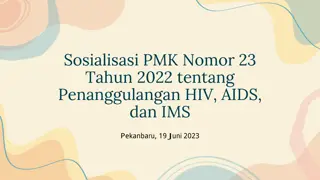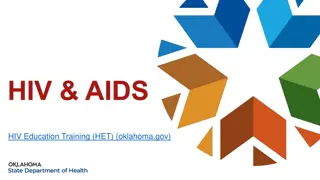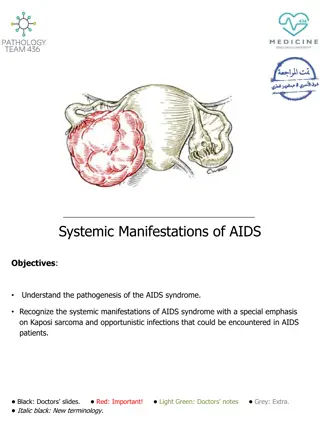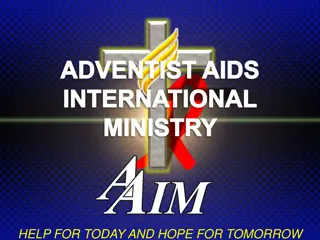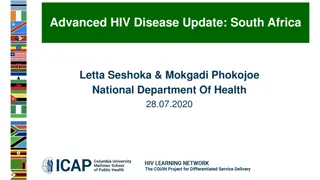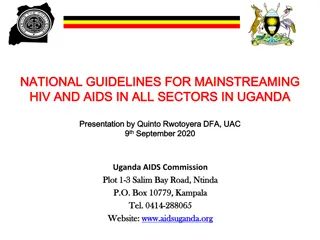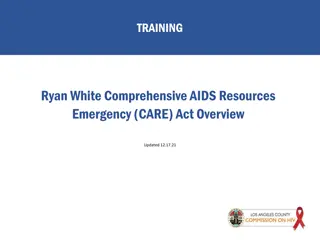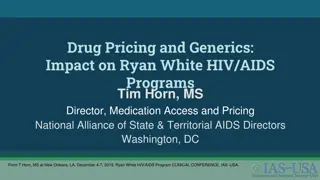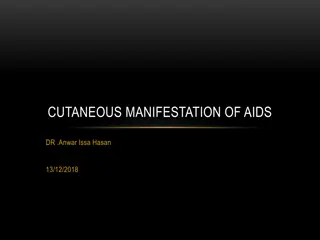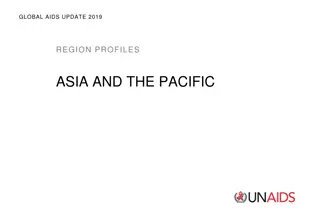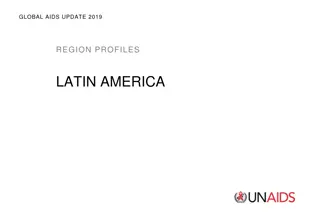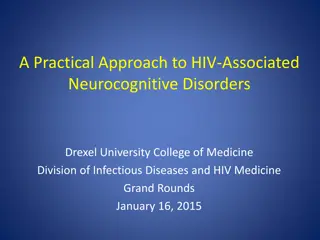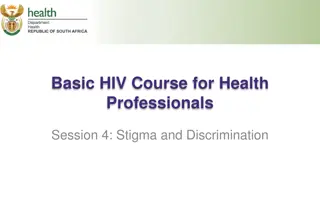National Native HIV/AIDS Awareness Day - Impact and Facts
National Native HIV/AIDS Awareness Day, observed on March 20, 2013, sheds light on the impact of HIV/AIDS in Native communities. Learn about the disparities, risks, and initiatives to promote testing and education. Explore statistics and facts on HIV infections among American Indians, Alaska Natives, Native Hawaiians, and other Pacific Islanders. This day honors those affected by the disease and aims to raise awareness in Native populations.
Uploaded on Feb 25, 2025 | 1 Views
Download Presentation

Please find below an Image/Link to download the presentation.
The content on the website is provided AS IS for your information and personal use only. It may not be sold, licensed, or shared on other websites without obtaining consent from the author.If you encounter any issues during the download, it is possible that the publisher has removed the file from their server.
You are allowed to download the files provided on this website for personal or commercial use, subject to the condition that they are used lawfully. All files are the property of their respective owners.
The content on the website is provided AS IS for your information and personal use only. It may not be sold, licensed, or shared on other websites without obtaining consent from the author.
E N D
Presentation Transcript
Honor Our Ancestors, Protect Our People, Take the Test! National Native HIV/AIDS Awareness Day (NNHAAD) March 20, 2013
About NNHAAD National Native HIV/AIDS Awareness Day (NNHAAD) is held on the first day of Spring each year. This day was selected by the Native community, nationally, via survey. It was believed that this day best exemplified the ceremonies that occurred on the Spring Equinox for all Native groups (American Indian, Alaska Native, and Native Hawaiian). It was initiated in 2007 and since that time, has been successful in promoting and educating Native people about HIV and AIDS. On this day, we encourage all Native communities to plan events to promote HIV testing and continue educating on HIV/AIDS. It is also a day to honor those who are infected and affected by the disease, as well as to honor those who have passed as a result of AIDS-related complications.
HIV/AIDS Impact in Native Communities Historically, Native communities have experienced higher rates of numerous health disparities than other racial/ethnic group including HIV/AIDS. American Indians, Alaska Natives and Native Hawaiians are at a greater risk for HIV infection because of the co-factors that present both health and economic challenges. These include sexually transmitted infections, poverty, alcohol abuse, intravenous drug use, and social risk co-factors (homophobia, mistrust/distrust of Western medical systems, etc.)
Impact Compared to Other Ethnic Groups Native Hawaiians/Other Pacific Islanders and American Indians/Alaska Natives had the 3rdand 4thhighest rate of new HIV infections, respectively. By the end of 2008, the rate was 22.8 per 100,000 persons for NHOPIs and 11.9 per 100,000 for AI/ANs.1 Of persons who were diagnosed with HIV, AI/ANs had that shortest overall survival time, with only 88% living longer than 3 years.2 Of persons who were diagnosed with HIV, almost 30% progressed to an AIDS diagnoses in less than 12 months.2 1 Centers for Disease Control and Prevention. HIV Surveillance Report, 2009; vol 21. http://www.cdc.gov/hiv/topics/surveillance/resources/reports/. Published February, 2011, Accessed June 21, 2011. 2 Centers for Disease Control and Prevention. HIV Surveillance Data Report 2010; vol. 22. http://www.cdc.gov/hiv/topics/surveillance/resources/reports/. Published March 2012. Accessed December 14, 2012.
Facts on the Impact In Native Communities HIV/AIDS AMONG AMERICAN INDIANS AND ALASKA NATIVES POPULATIONS HIV/AIDS AMONG NATIVE HAWAIIAN & OTHER PACIFIC ISLANDER POPULATIONS An estimated 851 Native Hawaiians/Other Pacific Islanders (NHOPI) have been diagnosed with AIDS.1 Since the beginning of the epidemic through 2010, 3,722 American Indians/Alaska Natives (AI/AN) have been diagnosed with AIDS.1 An estimated 1893 AI/ANs with AIDS have passed away.1 By the end of 2009, there were an estimated 4741 AI/ANs living with HIV/AIDS 3478 men, 1169 women and 49 children.1 An estimated 363 NHOPIs with HIV/AIDS have passed away.1 By the end of 2009, there were an estimated 1078 NHOPIs living with HIV/AIDS 884 men, 188 women, and 7 children.1 1 Centers for Disease Control and Prevention. HIV Surveillance Data Report 2010; vol. 22. http://www.cdc.gov/hiv/topics/surveillance/resources/reports/. Published March 2012. Accessed December 14, 2012.
Number of Cases of New HIV and AIDS Diagnoses Annually AIAN New HIV Dx AIAN New AIDS Dx NHOPI New HIV Dx NHOPI New AIDS Dx 250 225 221 200 208 207 Number of Cases 170 167 150 136 127 100 72 67 64 62 50 52 47 44 42 0 2007 2008 2009 2010 Centers for Disease Control and Prevention. HIV Surveillance Data Report 2010; vol. 22. http://www.cdc.gov/hiv/topics/surveillance/resources/reports/. Published March 2012. Accessed December 14, 2012.
Number of Native People Living with HIV or AIDS Annually AIAN Living with HIV AIAN Living with AIDS NHOPI Living with HIV NHOPI Living with AIDS 3200 3039 2800 2930 2825 2400 Number of Cases 2000 1658 1601 1528 1600 1200 800 607 541 486 400 471 426 399 0 2007 2008 2009 Centers for Disease Control and Prevention. HIV Surveillance Data Report 2010; vol. 22. http://www.cdc.gov/hiv/topics/surveillance/resources/reports/. Published March 2012. Accessed December 14, 2012.
Transmission Categories among American Indians and Alaskan Natives Centers for Disease Control and Prevention. HIV Surveillance Data Report 2010; vol. 22. http://www.cdc.gov/hiv/topics/surveillance/resources/reports/. Published March 2012. Accessed December 14, 2012.
Transmission Categories among Native Hawaiians and Pacific Islanders Centers for Disease Control and Prevention. HIV Surveillance Data Report 2010; vol. 22. http://www.cdc.gov/hiv/topics/surveillance/resources/reports/. Published March 2012. Accessed December 14, 2012.
HIV/AIDS Among Native Children Since 2007 there have only been 2 American Indian/Alaska Native children under the age of 13 documented as diagnosed with HIV with no diagnoses in 2009 or 2010.1 Since 2007, there has not been any Native Hawaiian or Other Pacific Island child diagnosed with HIV.1 Between 2007 and 2010, no Native child under the age of 13, has been diagnosed with AIDS.1 It is, however, important to note that data for American Indians/Alaska Natives is under-reported. 1 Centers for Disease Control and Prevention. HIV Surveillance Data Report 2010; vol. 22. http://www.cdc.gov/hiv/topics/surveillance/resources/reports/. Published March 2012. Accessed December 14, 2012.
IHS Testing by Year 80000 70000 67749 60000 57630 57634 51052 50000 46679 40000 # of tests conducted 30000 20000 12042 10000 0 2000 2007 2008 2009 2010 2011 Neel, L. (personal communication, December 26, 2012). US Department of Health and Human Services, Indian Health Service, Office of Clinical and Preventative Services, Division of Clinical and Community Services, HIV/AIDS Program. Collated from internal reports.
Indian Health Service HIV Testing Efforts 90 82 80 79 78 80 74 65 70 60 54 50 40 30 20 10 0 2005 2006 2007 2008 2009 2010 2011 % Received Prenatal Screening Neel, L. (personal communication, December 26, 2012). US Department of Health and Human Services, Indian Health Service, Office of Clinical and Preventative Services, Division of Clinical and Community Services, HIV/AIDS Program. Collated from internal reports.
Get on boardpost your event on www.nnhaad.org/
Host an Event for NNHAAD Types of Events held during past NNHAAD s: Health Fair Confidential HIV Testing Information Booths Mini workshops Mini Powwow Theatre Performance Candlelight Vigil Sunrise Ceremony
Other Ways to Honor NNHAAD Walk for Awareness Tribal/Religious Ceremony Wear Red Ribbons in your Organization Create a youth education/awareness event Host an Assembly with a guest speaker Market the NNHAAD materials (poster, save the date card) Post on social marketing networks
Other Awareness Days February 7 National Black HIV/AIDS Awareness Day March 10 National Women & Girls HIV/AIDS Awareness Day May 18 HIV Vaccine Awareness Day May 19 National Asian & Pacific Islander HIV/AIDS Awareness Day June 8 Caribbean American HIV/AIDS Awareness Day June 27 National HIV Testing Day October 15 National Latino AIDS Awareness Day December 1 World AIDS Day
NNHAAD Committee Asian & Pacific Islander (API) Wellness Center (415) 292-3400 www.apiwellness.org Commitment to Action for 7th-Generation Awareness & Education [CA7AE]: HIV/AIDS Prevention Project (800) 642-0273 www.happ.colostate.edu Great Plains Tribal Chairmen s Health Board (GPTCHB) Northern Plains Tribal Epidemiology Center (NPTEC) (605) 721-1922 www.gptchb.org Inter Tribal Council of Arizona, Inc. [ITCA] (602) 258-4822 www.itcaonline.com National Native American AIDS Prevention Center [NNAAPC] (720) 382-2244 www.nnaapc.org
Additional Resources Centers for Disease Control and Prevention (CDC): www.cdc.gov Substance Abuse and Mental Health Service Administration (SAMHSA) - MAI: www.samhsa.gov Find a local testing site at: http://www.hivtest.org Get Federal information on HIV/AIDS at: www.AIDS.gov Send a text message with your zip code to KNOWIT (566948) to find a local HIV testing center. National HIV/AIDS Hotline: 1 (800)232-4636 1 (800)344-7432 Spanish 1 (800)243-7889 (TTY/TDD)



